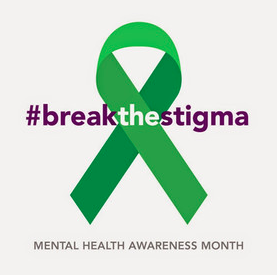May is Mental Health Awareness Month. To me, mental health is just as important as physical health–if not more vital. Sometimes, to those of us affected, they effect each other, but the preconceived notions and underlying stigmas associated with it can easily influence those diagnosed to suffer in silence. I hope to dispel some of the common myths regarding mental illnesses. Mental illness covers an array of disorders, so allow me to shine a light on them here:
Anxiety Disorders: People affected with anxiety disorders respond to objects or situations with fear or dread. They may also respond physically with a rapid heartbeat or sweating, tremors, nausea, headaches and even muscle tension. General Anxiety Disorder, Panic Disorder, PTSD and OCD are common anxiety disorders.
Psychotic Disorders: These disorders can involve having hallucinations with images or sounds that aren’t real as well as delusions and false fixed beliefs the person believes to be true. Schizophrenia is the most common type of this disorder, although hallucinations can also be present with bipolar disorder.
Eating Disorders: Attitudes and behaviors involving weight and food. Anorexia Nervosa and Bulimia Nervosa are the most common within this group.
Impulse Control Disorder: These people are unable to resist urges or impulses. Some examples are pyromania, kleptomania and compulsive gambling.
Personality Disorders: These people have extreme and inflexible personality traits that are distressing to them. Can cause problems with work, school and normal functioning in general. They include Antisocial Personality Disorder and Paranoid Personality Disorder.
Mood Disorders: Mood disorders are known as affective disorders such as depression or bipolar disorder.
I Intentionally listed this disorder last because I’m extremely familiar with it–it’s a part of who I am.
It’s always disappointing when I hear anyone who observes someone else’s unusual behavior and automatically assumes that they’re bipolar. Bipolar Disorder only affects a small percentage of the general population–roughly 2.6% are diagnosed as bipolar. Sadly, statistics show that half of those diagnosed end with suicide, 1.6%. Moreover, 25% of those suicides are usually violent in nature.
Bipolar Disorder is a lifetime journey of cycling from the heights of mania, feeling God-like, invincible, and compulsive. Then crashing headfirst into the deep, dark pit of despair and depression. You find yourself powerless and without the necessary energy to pull yourself out. Even when a ladder constructed of medication and therapy is thrown into the hole for you to pull yourself out, you only manage to climb a few rungs before hopelessly falling back down. Formally known as manic depression, it’s debilitating and with you for a lifetime. Like I previously mentioned, it can lead to suicide. While I’ve never felt like committing suicide, if I’m honest, I can recall numerous times I’ve wished for death.
Even though May is Mental Health Awareness Month, I encourage everyone to take the time to learn more about mental illness disorders. With most of them being hereditary, chances are a family member or maybe a close friend will be affected. My prayer is for my journey to educate and inspire others to become more aware and hopefully eradicate the negative stigma associated with it. We can’t deal with something as serious as mental health without first shining a huge light on it and acknowledging its existence.

